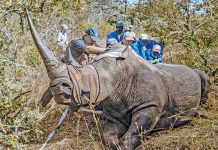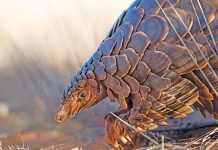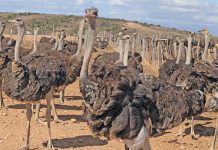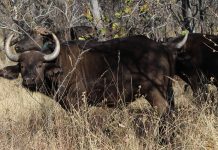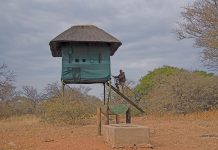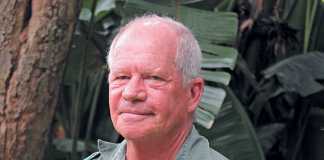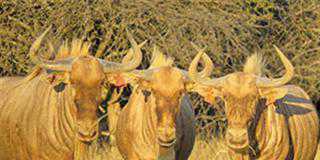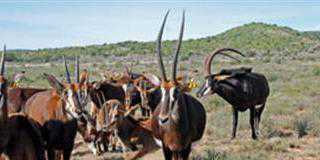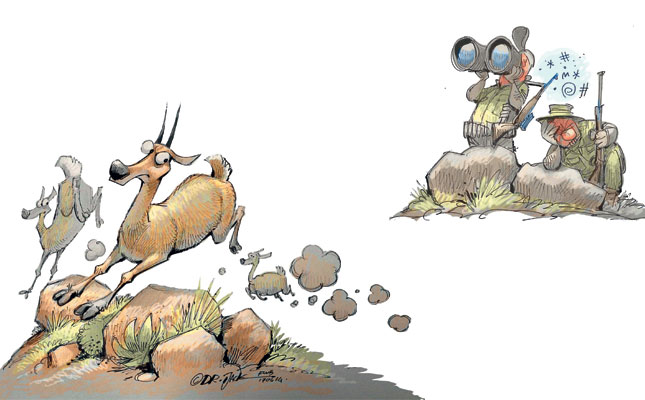
James Mellon, whom I envied when growing up and tried to emulate when older, and who later befriended me, wrote in his 1977 African classic, African hunter, that “the vaal [grey] rehbok (sic) […] from the standpoint of hunting difficulty, is the top trophy” in South Africa.
Bruce Truter, one of my favourite hunting writers, in his inimitable humorous manner, wrote, “Often the first thing that springs to mind on spotting a rhebok is the revelation that one was damn lucky just to have seen it.
The grey fur that covers them is more like that of a rabbit than of an antelope, so there is never that slight sheen to catch the hunter’s eye the way there is with smooth-haired game when the sun is in the right place to reflect some light.
As if this weren’t unfair advantage enough, the colour of the fur so accurately duplicates the natural hues of the Karoo koppies that a rhebok, especially one lying down, actually looks more like a slab of weathered sandstone or clump of dry grass than does the real thing.”
To make matters worse for the hunter, Truter explains, the rhebok bolts at the merest sniff of danger.
“A few antelope species are fairly curious, though admittedly their curiosity is well mixed with caution. Rhebok are not curious. They run first and ask questions afterwards, if at all. They really don’t seem to give a damn about who or what the opposition is.
Their motto is, if it isn’t navigating on four legs – or even if it is but is wearing a hat – then it is time to immediately get the hell out of there. And getting away does not mean a hundred or two hundred or three hundred metres away. To rhebok, getting away means not even slowing down until they are at least two mountain peaks away.”
I agree with James and Bruce; the ‘veld phantom’ wins my vote as the most challenging of South African game animals and I believe this small, furry, grey animal is the top trophy in Southern Africa.
Masked by the terrain
Rhebok occur in small groups; the most I have seen together is 12. Usually, however, the groups consist of a single ram and one or two females with their offspring. Solitary males are often also found.
Rhebok are normally found on the side of a hill, where they are almost invisible to the hunter, even one using a spotting scope. These antelope seem to know that if they remain motionless, they are as good as invisible. Moreover, they feed early in the morning and late in the afternoon when the grey shadows help mask their movements.
From about 10am until late afternoon they bed down. Even if you do manage to spot them, the places they choose to bed and their outstanding senses make it difficult, if not well-nigh impossible, to stalk them.
The method that I have used with most success is to be up in the mountains before dawn in areas where I have a good view over well-known grey rhebok territory. Essential equipment include a good spotting scope, a range finder and a fast, flat-shooting calibre, as shots are often long and over dead ground from one valley wall to the next.
Bigger is better
The world record grey rhebok, with horns measuring 11⅞” was shot in Riversdale in the Cape Province in 1994 by a shy, young, 11-year-old boy, aptly called Abri de Jager (jagter is Afrikaans for hunter, and is derived from the Dutch jager).
I had the pleasure of meeting him at SA Hunters 22 years ago when he entered his spectacular trophy in the annual competition.
If the Holy Grail for kudu hunters is a 60” bull (some 13% more than the Rowland Ward minimum of 53⅞”), then a 9” grey rhebok is the equivalent, as the corresponding minimum is 7⅞”.
Jonathan Kingdon, in his Field guide of African mammals, states that the grey rhebok may be distantly related to the oribi and kob, but today has little in common with either. He disagrees with RHN Smithers, who writes in his The mammals of the Southern African sub-region that grey rhebok are browsers.
Kingdon maintains that they are mainly grazers that do not require drinking water. He goes on to add that they are most numerous in strongly seasonal pastures above 1 000m, and stay at these heights during the rainy season, but descend to lower slopes during dry periods.
For many years, South African farmers shot out the grey rhebok on their lands as they believed the meat was inedible. This was largely due to the fact that the warble fly lays eggs in the antelope’s woolly coat.
When the eggs hatch, the larvae penetrate the skin and live there for a while as 25mm-long, white maggots before leaving the skin to pupate.
The unpopularity of the grey rhebok amongst farmers was compounded by the belief that they killed mountain reedbuck, whose flesh was considered excellent table fare.
Kingdon goes on to state that, today, “the rhebok is well represented in numerous reserves, national parks and private farms where it is, for the most part, compatible with livestock. Although it has been exterminated over a large part of its former range, which is now very fragmented, it is common within these fragments.” It is not endangered.
Smithers puts it this way: “Within the limits shown on the map (essentially the southern half of Africa), they only occur where there is suitable habitat; consequently, their distribution is discontinuous and patchy.”
Hunting the rhebok
I shot my last and best grey rhebok in the dead of a bitterly cold Karoo winter near the top of a koppie jutting some 370m out of the flat grassy plain. Here the rough, red, ironstone-strewn and renoster bush-tufted flanks of Big Belly reared up from the plains to a protruding line of red brown rocks, which, like a line of fresh scabs, marked the first false crest of this steep hill-cum-mountain.
Undaunted by our long day in the veld – we had been out before dawn – Lalase Maso, my fit, young, ever-smiling Xhosa guide, glided up the steep slope with no break in stride. I followed reluctantly. The dull ache in my knees and lower back rendered all thought of bending down to tie my bootlace irrelevant. We were 1 500m above sea level and my lungs were labouring.
I tried not to look up at the saddle high on the side of the koppie, which we were aiming for, but concentrated instead on settling into my climbing rhythm, now a series of ugly, jerky heaves.
Only my pride kept me close behind the heels of the young man’s sturdy, black hiking boots. Relief washed over me when I saw them halt, side by side, on a lichen-covered boulder.
“Sien Meneer Flack die rooi ribbokke? [Can you see the mountain reedbuck, Mr Flack?]” he asked, pointing while displaying no hint that he had just climbed a good 250m from the valley floor.
I had twice gently explained that I was Peter and only my father was Mr Flack, but his culture and upbringing would simply not allow him to call me by my first name.
The strap of my Leica Geovid binoculars-cum-range-finders under my left armpit had become trapped by the broad webbing sling of my custom-made, .300 Winchester Magnum, a Walther barrel married to a Brno action, set in a handmade, wooden stock to match my .375, topped by a 2.5-10×42 Zeiss Diavari Z ’scope, with a Harris bipod securely attached to the reinforced front sling swivel.
I wrenched the binoculars free and looked. The soft, white, underbelly fur of the mountain reedbuck gave away the six, no, seven, family members as they stood at attention at the edge of the dark grey shadow creeping down the slopes of Big Belly.
“Sien Meneer Flack, agter die ribbokke staan daar nog… nee [Mr Flack, can you see, behind the mountain reedbuck, there are others… no]. Then his voice changed sharply: “Dis vaal ribbokke daai [Those are grey rhebok]”.
Could it be? “Waar? [Where?]” I asked.
“Agter, teen die randjie, tussen daai twee groot besembosse [Behind, against the little ridge, between those two big broombushes],” he replied and pointed at the same time.
“En die een links lyk soos a goeie ram [And the one on the left looks like a good ram],” he added, with the excitement tingeing his voice as his martial eagle eyes picked up details I could not see.
Closing the gap
To the front, the false crest of the ridge rolled away to a gentle sloping fall while dropping more steeply to the left. From the hollow to our front, it rose again in a series of steps before climbing steadily, at a steep gradient, to the top of the rounded belly of the koppie.
I could see that, with a bit of luck, we might be able to detour to our right and use the false crest to close the gap.
When we ran out of cover, my range finder measured the distance to the ram at precisely 284m. During our detour, I had ample time to prepare for the shot and had long since extended the bipod.
Lalase and I crawled over the ridge of the false crest. I was glad that I was wearing leather gloves and well-cushioned, rubber knee pads as the going was all thorn scrub and loose rock.
I could not lie and shoot as the ram was much higher up the slope than me, and so I slowly sat up and buried the feet of my bipod between the laces of my hiking boots. I was not really comfortable shooting uphill from this angle, but there was no time to lose as the animals had become aware of our presence and were merely startled into stillness by their surprise.
Within seconds they were going to up and leave at pace.
The 165-grain Blazer, soft-nosed bullets dropped 7½” over 300m on my practice range and, in the still air, I held as best I could behind the foreleg and level with the back of the tiny antelope as the crosshairs shimmered around the point of aim.
This is where fitness is crucial; the fitter you are, the less of a tremor your hands develop at the end of a hard day’s hunting. As I recovered from the recoil and picked up the antelope again in the scope, it was uncharacteristically running diagonally downhill at full stretch.
Through the scope I saw a red carnation of blood blossoming behind its foreleg and the buck barely managed 30m before slowing to a halt and collapsing.
For more about Peter Flack, his books, DVDs, articles, newsletters, blog and SHAC, visit peterflack.co.za.

